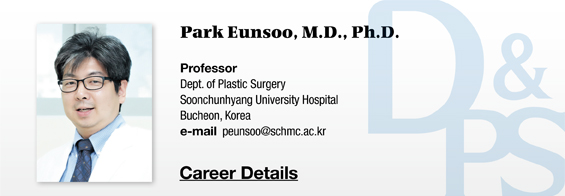The adult stem cell deprived from the bone marrow is the first known to be capable of proliferating in an undifferentiated state and multipotent to cells of other tissues. Afterward, adult stem cells are understood to be isolated from cord blood or peripheral blood, and to exist everywhere such as the placenta, skin, and nervous tissues in a human body. Bone marrow stem cell (BMSC), however, induces pain in the course of collection and is limited by the inability to obtain sufficient amount at a time. Blood-derived stem cells do not provide sufficient amount and are not appropriate for long-term provision. Fat cells, however, can be obtained in relatively large quantity, by liposuction for body sculpture. Liposuction is a safe and easy procedure, conducted for about 30 years until now. Isolating adipose-derived stem cells from fat tissues is the easiest way to collect sufficient amount of adult stem cells. The reported profile and potency of adipose-derived stem cells are not inferior to other sources of adult stem cells, and such profile is maintained across every age group. Prof. Yoshimura (Tokyo University) conducted breast augmentation by Cell-Assisted Lipotransfer (CAL) method, which uses adipose-derived stem/stromal cells (ASCs) for fat graft, and enhanced the survival to more than 70% compared to the conventional method. Since then, the interest and attempt for clinical application of this method have increased explosively.
[Ad. ▶Ultra Skin/Pastelle - Manufacturer: WONTECH(www.wtlaser.com)]
1. Definition and Characteristics
In 1992, microvascular endothelial cells stained with von Willebrand Factor (vWF), α-smooth muscle cell actin and cytokeratin were found in the stromal vascular fraction (SVF) isolated from human fat tissue. More recent studies found out the presence of cells similar to stem cells in these tissues and that these cells are multipotent stem cells. A adipose-derived stem cell is a type of an adult stem cell, and is a mononuclear cell obtained from fat treated with collagenase. It grows adherent to the culture disc and can be differentiated to various cells from muscle cells to bone, nerve, endothelial and bone cells. When the supernatant after lipase treatment is centrifuged, it is separated to the upper extracellular matrix and oil layer and the lower precipitated cell layer (pellet). The lower precipitated cell layer is called stromal vascular fraction (SVF), and this includes adipose-derived stem cells. The SVF, which is heterogeneous cell population before adipose-derived stem cell culture, cannot be applied to actual fat graft, and the term is often mixed with adipose-derived stem cell. Fat tissues obtained by liposuction yields from 1×107 to 6×108 adipose-derived stem cells per 300mL, and have been reported to have more than 90% survival rate. Adipose-derived stem cells are also known to be easily cultured, grow rapidly, and have delayed cellular aging than bone marrow stem cells.
2. Nomenclature
A adipose-derived stem cell has had various names so far from stromal cell to adipocyte progenitor cell (lipoblast, pericyte, preadipocyte), processed lipoaspirate cell, multipotent adipose-derived cell, adipose derived stem/stromal cell, adipose derived adult stem cell, adipose derived adult stromal cell, adipose derived stromal cell, adipose stromal cell and adipose mesenchymal stem cell. In 2004, International Fat Applied Technology Society has standardized the name to adipose-derived stem cell (ASC).
3. Surface Antigens of Adipose-Derived Stem Cell
Fat tissues contain a mixture of lipid-containing, differentiated fat cells, fibroblasts, endothelial cells, arterial smooth muscle cells and immune cells, in addition to stem cells. In order to be defined as a mesenchymal stem cell, a cell has to meet 3 conditions; first, it has to grow adherent to the culture disc; second, it should be able to differentiate to bone cells, fat cells and cartilage cells, in vitro; and third, it has to express certain cell surface antigens. Among various cell surface antigens widely known in immunology, adhesion molecules (CD29 , CD49e), such as integrin, hyaluronate receptors (CD44), cadherins (CD144), surface enzymes (CD73), extracellular matrix proteins (CD90, CD105), intercellular adhesion molecules (CD54), vascular adhesion molecules (CD106), complement regulatory proteins and histocompatibility antigens (HLA-DR) are expressed from mesenchymal stem cells. Mesenchymal and Tissue Stem Cell Committee of the International Society for Cellular Therapy defined the minimum condition of a mesenchymal stem cell as having specific antigens, such as CD105, CD73 and CD90, in addition to the two conditions mentioned above, and absence of hematopoietic stem cell antigens, such as CD45, CD34, CD14 or CD11b, CD79a, CD19 or HLA-DR. However, there is a controversy over the expression of CD34, which is known to be expressed by a hematopoietic stem cell. A recent study has attempted to define the presence and distribution of each cell line associated with angiogenesis of adipose-derived stem cells, by using flow cytometry and cell surface marker. According to this study, adipose-derived stem cells do not express hematopoietic stem cell surface antigens, such as CD14, CD16, CD56, HLA-DR/MHC class II and CD45, and do not even share white blood cell and CD31, an endothelial antigen. Furthermore, it was known in the past that CD34 was not the marker of adipose-derived stem cell, but recent studies have reported its presence, despite several differences in the degree. This is suspected as CD34+ expressed by adipose-derived stem cells in the process of SVF treatment, but there are reports that it disappears it is in vitro culture.
4. Isolation and Culture of Adipose-Derived Stem Cell
Fat tissues accounts for the largest part of a human body; about ⅓ to ⅔ of fat tissues consist of lipid-containing fat cells, and the rest consists of blood cells, endothelial cells and preadipocytes. Fat tissues are involved with energy storage and metabolism, and are present around the bone structure, nervous system and cardiovascular system, working as a buffer from external impact and preventing adherences of important body organs. The tissue has very abundant microvascular matrix, which responds very well to transmitters, such as hormones and growth factors. It also plays an important role as a support for bone structure maintaining a delicate body contour and shape. Therefore, a fat tissue is not just a tissue but a gigantic organ, in terms of the importance of its roles. As fat tissues contain mesenchymal stem cells as well, an attempt to isolate various mesodermal tissues from fat tissues is being actively done in many studies. The method to isolate stem cells from liposuction or resected fat tissues has been introduced a lot in the literature. In summary, fat tissues are washed twice or three times with a solution containing antibacterial-antifungal agents and then cut into pieces. The fat tissues are agitated for 1 hour and a half in a 5% CO2 incubator at 37℃ using 0.1% collagenase type l. Then the enzyme activity is neutralized with complete media containing same amount of Dulbecco’s Modified Eagle’s Medium (DMEM), 10% fetal bovine serum (FBS) and 1% antibiotics. After centrifuge for 5 minutes at 1,000rpm, the supernatant is removed, the lower cellular pellet is sieved with 70μm nylon net, followed by culturing with complete media in 5% CO2 incubator at 37℃. After about 24 hours of culture, the media is renewed. The precipitated SVF are easily adhered to the culture disc and proliferates within days. Early cellular pellet contains endothelial cells but is left with stem cells after several subcultures. Some fibroblasts may adhere and proliferate, so there is still a controversy over whether these cells are left in stem cells only. Therefore, some investigators isolate stem cells with cytometry sorter using specific cell surface antigens. The yield of stem cells differs among individual body part; it has been reported that the yield is higher from the arms compared to the thighs and the abdomen.
5. Limitations in the Clinical Application of Adipose-Derived Stem Cell
The biggest controversy in the study of adipose-derived stem cells is in the lack of standardizations of a study, such as using bulk culture of adipose-derived SVF to initiate the culture in the majority of studies. Despite SVF being a heterogeneous cell population, only small proportion of these cells adhere to the culture disc and proliferates. A lot of studies so far have involved adipose-derived stem cells in the absence of definite marker, but the possibility of using mixed cell groups containing other cells than dipose-derived stem cells cannot be ruled out. Therefore, a method ensuring quality assurance and control should be prepared for stem cell extraction.
Second, as mentioned above, fetal bovine serum is used for cell culture, despite the principle to use human serum for stable cell culture, giving rise to the risk of mad cow disease or other xenogenic infections.
Third, the storage, container, marking, transfer and storage deadline of adipose-derived stem cell should be standardized.
Fourth, there is an issue with regard to how long adipose-derived stem cells should be cultured for. There have been reports that more than 4 months of in vitro culture of adipose-derived stem cells resulted in malignancy.
Fifth, malignancy can recur when using adipose-derived stem cells from patients with a history of malignancy or from the site where radiotherapy was applied.
-To be continued-
▶ Previous Artlcle : #5. Stem Cell: Adult Stem Cell
▶ Next Artlcle : #7. Adipose-Derived Stem Cell II – Multipotency





















